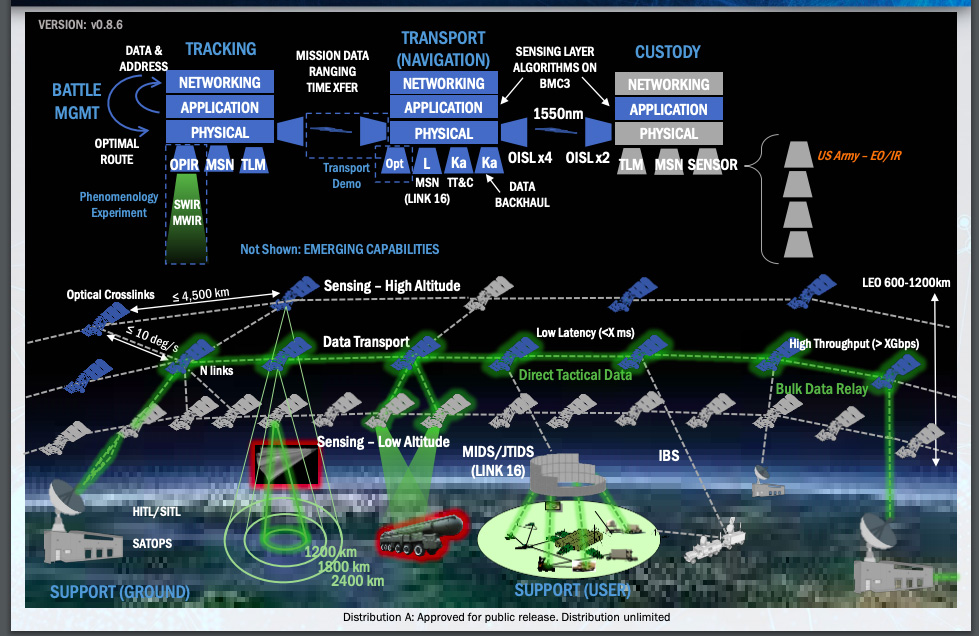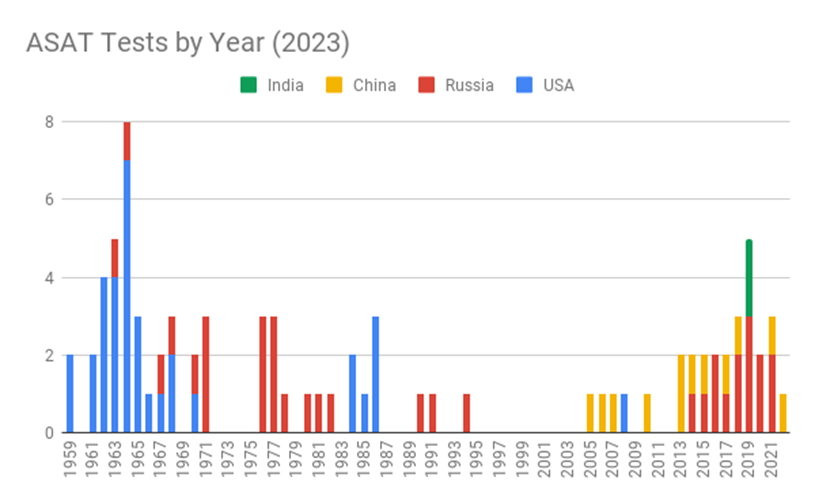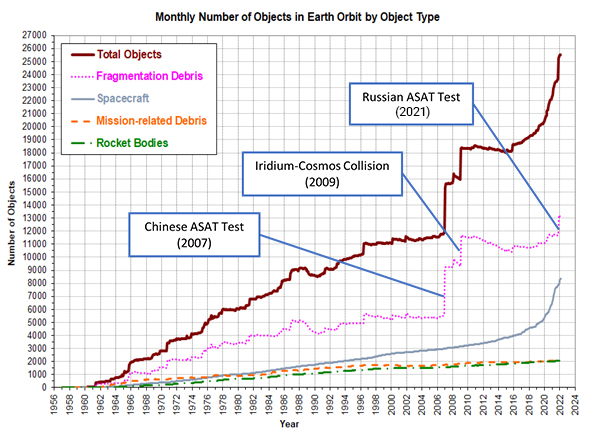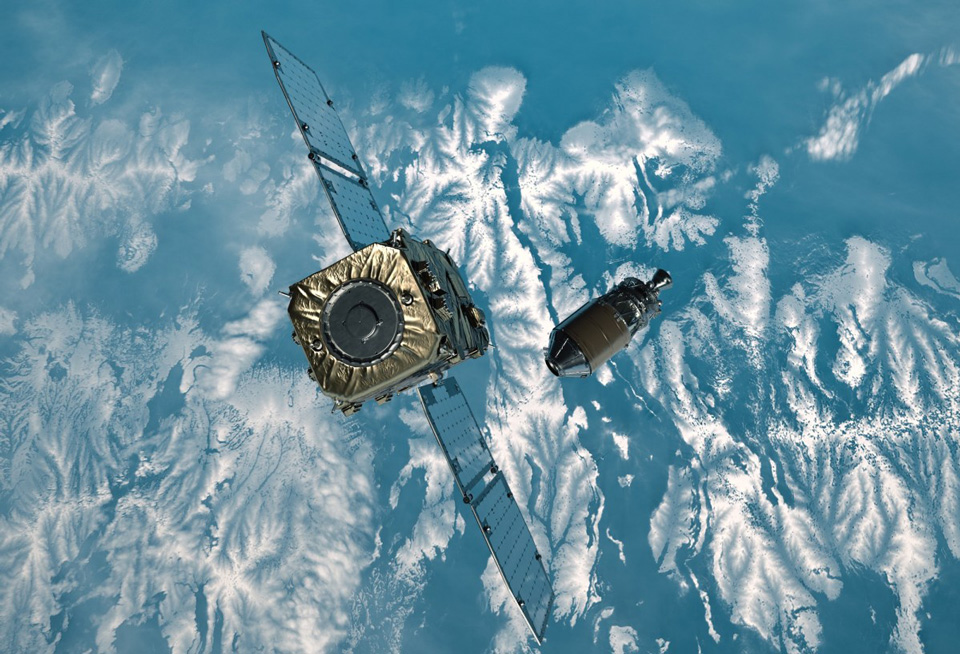Any activity in space starts first and foremost with safety. This priority stands atop all stages of a spacecraft’s life — from the stage of design and construction to maintenance and subsequent disposal. This is no wonder, as safety in outer space directly affects safety on Earth. In modern life, the loss of satellites threatens to completely disrurpt all spheres of state and institutional management, from the banking system to communications, from logistics to navigation. But first of all, it would be ruinous for the defense sector.
To prevent these fatal consequences, a clear code of uniform international safety regulations on behavior in space needs to be developed, along with a reliable mechanism for monitoring space traffic. However, since the level of geopolitical confrontation is increasing down on Earth, there is now no chance of ensuring a transparent exchange of information (especially when it concerns the route of movement of satellites and military spacecraft).
Global military satellite networks
The number of countries entering orbit is growing almost every year. With the arrival of new players, the variety of interests that they seek to defend through their own space sectors is also expanding.
Countries have been particularly interested in strengthening their national security by using military, geospatial and monitoring satellites to obtain external intelligence, situational control, battlefield management capabilities. Coordinated under a single command, these satellites are capable of providing a military with overwhelming information and awareness that can be used to gain an advantage in combat.
The latest American military doctrines rely on satellites for almost everything. They are the key link in Joint All Domain Command and Control (JADC2), which provides for the creaton of a unified management network for command and control of all types of military operations. The US is currently allocating a great deal of money to developing this capability.
This year, JADC2 and other US Department of Defense space strategies are set to receive $33.3 billion in budgetary funding, which will be distributed as follows:
- $5 billion for missile warning and tracking (covering two main areas: $2.3 billion for new distributed resilient architectures and $2.6 billion for next-generation permanent infrared connectivity).
- $1.3 billion for the development of positioning, navigation, and time synchronization programs, including the development of a next-generation operational control system for GPS.
- $3 billion for the development of 15 launch vehicles (to deploy military satellites into orbit) and modernization of these rockets’ ranges.
- $4.7 billion for secure and interference-resistant satellite communications. This money is first and foremost intended for a main space system of command and control called the Transport Layer, being developed by the Space Development Agency.
The transport layer is a constellation of 20 tactical-level satellites that can be expanded by connecting a number of commercial spacecraft that the Defense Department plans to lease from private companies. The transport layer will allow the US military to link its command over each object on the battlefield within a single network layer. Orbital transport-level communications nodes will play an important role in the coordination of all branches of the military, especially taking care of the transmission of time-sensitive data from reconnaissance drones, and will also take over the navigation and logistics functions of Space Force Command.
The Transport layer multi-level system provides for the harmonized coordination of two main types of satellites located at different orbital altitudes. Sensor-level satellites will be placed within LEO (600 km) and will be responsible for tracking hypersonic ballistic missiles with the ability to maneuver, and will also respond to sudden movements of enemy troops.
Sensor level devices will transmit the received intelligence data to the second level of Transport layer satellites, which are located at a higher altitude (1200 km). These will act as a link to the US’s main ballistic missile warning satellites. Their duties will include relaying the geospatial GPS signal (transmission of these types of data is undertaken by each of the constellation’s satellites).
Communication satellites will interact with each other through laser communication channels, which will give the American military an advantage in the speed of receiving information.

To increase stability in orbit, the Space Development Agency has put forward a fundamentally new approach for the military, which consists of leasing commercial satellites from companies that meet the standards set by the Transport layer. In this way, remote sensing and communication satellites of American commercial companies will become a link in an extensive data transmission network. However, before this practice becomes widespread, uniform optical satellite communication standards and reliable signal encryption systems must first be proposed.
SDA seeks to move away from its traditional practice of producing new satellites from scratch to order and significantly reduce the burden on its own military satellites by involving already-functioning satellites from the commercial sector. This practice has many advantages, although it also has one serious security disadvantage — commercial satellites involved in the Transport layer could become potential targets in the event of a conflict in space. This especially applies to those countries that have been developing new types of anti-satellite weapons over recent decades.
Anti-satellite weapons: security that begets danger
The increasing influence of extensive satellite networks on the conduct and coordination of modern warfare has made America’s main strategic opponents consider developing satellite countermeasures. The latest of these include means to disable, capture, eliminate, or otherwise destroy sensor and telecommunications satellites.
The most available means for destroying satellites today is the anti-satellite (ASAT) direct ascent kinetic damage weapon. These ballistic missiles can be launched from land-based complexes (mobile and stationary launchers), sea-based launchers (ships and submarines), and aerial platforms (aircraft).
In one form or another, anti-satellite missiles have been known for a long time. The US, for example, conducted tests of its own ASM-135 ASAT missiles back in 1985. However, these weapons have only now become a real threat because the planet’s orbit has become overcrowded with space vehicles.

The main major threat from a massive ASAT launch against satellites is known as a Kessler Syndrome event, in which an over-saturation of orbital debris would cause an uncontrolled cascade of collisions with spacecraft in orbit (thereby generating even more debris).

The reality is that even without the widespread use of anti-satellite weapons (which have been tested around 100 times since 1959), the amount of large debris in orbit (10 cm or more) today has already reached ≈ 34,000 fragments. Add over a hundred million more smaller fragments (less than 1 cm) — and the picture becomes even scarier.

The start of tests of Chinese and Russian ASAT weapons in the new millennium is, first and foremost, a consistent strategy to contain US dominance in space, because space assets currently account for the lion’s share of America’s organization of its intelligence, military communication and command, positioning and navigation, and as well as missile early warning systems. According to John F. Plumbing, the US Assistant Secretary of Defense for Space Policy, both countries are now continuing to develop means to harm American satellites, with the PRC betting on the creation of ground-based precision counterspace combat systems, and Russia relying mainly on a large number of direct-ascent kinetic anti-satellite missiles. The disabling of US military satellites during an open military confrontation would threaten to quickly nullify the entire coherence and coordination of the American military machine.
The threat of ASAT weapons of direct destruction is not the only strategy for combating American satellites. A number of methods of “soft” damage, which the Russians and Chinese are working on, involve disabling or blocking the operation of satellites with blinding lasers, as well as carrying out cyber attacks to interfere with satellite signals. Satellites damaged and rendered uncontrollable as a result of such attacks, although not broken into small pieces, can pose a danger to other spacecraft moving in orbit.
One of the latest examples of the use of “soft” counterspace weapons was the Russian cyber attack on Viasat satellites during the full-scale invasion of Ukraine (recall that Viasat satellites help the Ukrainian military in organizing command communications). The Russians have also repeatedly tried to jam the signal of Starlink satellites, which are used to coordinate the actions of Ukrainian units.
As the 2023 report Global Counterspace Opportunities rightly notes, ASAT weapons have been present in our lives for a long time, but are today increasingly being developed by countries as purely offensive
It may seem that the sharp increase in the number of telecommunication communication satellites, which now sometimes number up to several thousand satellites in a constellation (as with SpaceX’s Starlink), has made the use of ASAT missiles impractical, because even a high percentage of hits on such targets can only weaken the provision of telecommunications services. But this view is wrong. When the critical level of orbit saturation and the formation of Kessler’s syndrome is reached, putting new devices into orbit can become problematic.

The latest attempt to introduce a moratorium on anti-satellite weapons testing at the UN came on December 7, 2022. It was at that point that a resolution on “Destructive Direct-Ascent Anti-Satellite Missile Testing” (DA-ASAT) was passed by the General Assembly, aimed at ending the arms race in outer space and reducing the risks that could bring armed conflicts into orbit. The initiative for this international action came from the US, with Vice President Kamala Harris first speaking on the issue in April 2022.
The majority of the conscious world supported the American security appeal. The resolution garnered 155 votes for and nine against. It hardly bears mentioning that the countries voting against are all members of an outspoken anti-western bloc, namely Iran, Belarus, Russia, Syria, China, Bolivia, Cuba, and Nicaragua.
For these states, ASATs were and remain a weapon of intimidation and containment of the American interests – how else can one explain their reluctance to forbid anti-satellite weapons? The UN’s pacifist appeals on this path can only be welcomed, but recent events have already proven more than once how ideas formed by diplomats can turn out poorly in reality. This is especially the case when there is no alternative influence on the opposite side, since reliable countermeasures against direct-ascent ASAT missiles remain an urgent issue.
Business Response to the Threat: A Flexible Approach
Of course, the big aerospace business welcomes US calls to abandon ASATs. No right-headed entrepreneur would be excited about the risks of turning his industry into a military training ground.
One of the biggest official statements by a major space business in support of a ban on the use of anti-satellite weapons was issued on November 14, 2023. The document, entitled Space Industry Statement in Support of International Commitments Not To Conduct Destructive Anti-Satellite Testing, was signed by 26 large aerospace companies and young startups from the US, Japan, Switzerland, Italy, India, France, Canada, Great Britain, and the Netherlands.

The wide range of the signatories’ countries emphasizes the global nature of the security problem posed by ASAT weapons. Today, the fact that the further militarization of space is one of the biggest challenges to the sustainable economic growth of the space sector is becoming more and more clear. This has garnered the attention of all areas of the satellite business: from simple monitoring weather probes to satellite mega-constellations with multi-level architecture.
In addition to the threat of ASAT rockets, the large number of new satellites (especially those appearing in LEO) also worries the business. The critical oversaturation of the orbit itself could make it unusable within a few decades. And all this is happening while the number of private players in the aerospace sector continues to increase: as of 2021 alone, this figure has already reached 10,000 space companies.

In this maelstrom of new strategies and technologies being developed for use in orbit, some are inventing means specifically to remove debris from orbit, mostly through the use of robotic manipulator spacecraft that capture and remove debris from orbit and redirect it into the Earth’s atmosphere, where it burns up. One startup offering a similar strategy for combating orbital debris is Switzerland’s ClearSpace, which recently won an 86 million euro contract from the European Space Agency (ESA) to de-orbit the wreckage of the 100-kg Vega rocket booster.
Japan’s Astroscale also has working solutions for the deorbit of rocket modules and debris. The company is developing a spacecraft, called the ELSA-M, and could conduct its first demonstration as early as this year by deorbiting an inactive satellite of the OneWeb constellation. Another Astroscale spacecraft, called the ADRAS-J, will attempt to remove the remains of an H-2A rocket’s upper stage.

An alternative option for combating the accumulation of orbital debris is the development of new systems for space awareness and space traffic monitoring by the startup Scout Space. In November 2021, the company won a US Air Force contract to integrate data from satellites and ground-based sensors to monitor objects in orbit.
Other solutions involve the use of new types of orbital thrusters for orbit correction, mostly powered by electric thrust. Recently, the French startup ThrustMe conducted the first on-orbit tests of an innovative, iodine-fuelled NPT30-I2-1U electric power unit. This will be the first iodine power unit to go into space aboard the Beihangkongshi-1 manufactured by the Chinese satellite company Spacety. The Ukrainian company SETS, which develops electric Hall-effect satellite engines, is also working on new types of reliable electric engines for orbit correction.
Thus, it is clear that in addition to supporting international security initiatives, the market has demonstrated a more flexible approach to actually cleaning up the consequences of using ASATs. It should also be stated that the principle of “if you cannot stop them, counter them” has proven effective in this respect.
It is important to realize that the means of combating orbital pollution that private industry is currently offering are only an interim solution to this global challenge. Only new rules for the operation and disposal of satellites, as well as a complete moratorium on the use of ASAT weapons in orbit, can help to fully handle this security problem.





